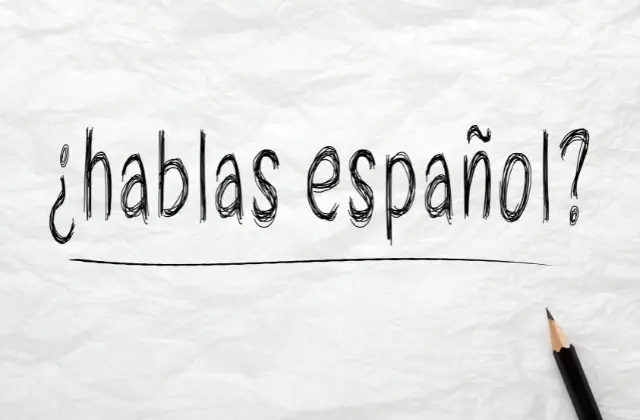You’ve got a Spanish fluency test coming up, and the thought of cramming verb conjugations and vocabulary lists makes you want to groan. What if there was a way to ace it without traditional studying?
The secret? Immersion.
By surrounding yourself with Spanish in a way that feels natural—almost effortless—you can train your brain to absorb the language like a native speaker. Here’s how to do it.
Shadow Native Speakers (Like a Language Spy)
“Shadowing” is a powerful technique where you listen to a native Spanish speaker and repeat what they say in real time, mimicking their pronunciation, rhythm, and intonation.
How to do it in 3 steps:
- Find short clips (YouTube, podcasts, or Netflix shows with subtitles).
- Play a sentence, pause, and repeat it exactly as you hear it.
- Gradually try to speak along without pausing.
This trains your mouth and ears simultaneously, improving fluency faster than flashcards ever could.
Binge-Watch—But Strategically
Instead of passively watching Spanish shows, make it an active learning experience. Start with subtitles (English first, then switch to Spanish). Pick shows you’ve already seen in English (e.g., Friends dubbed in Spanish—you’ll understand the context easily).
Listen for repeated phrases and jot them down. Your brain will start recognizing patterns without memorization.
Turn Your Daily Routine into a Spanish Drill
What you can do:
- Change your phone’s language to Spanish.
- Listen to Spanish music or podcasts while commuting.
- Label household items with sticky notes in Spanish.
The more you normalize exposure, the more natural comprehension becomes.
Think (and Talk) to Yourself in Spanish
Internal monologue in Spanish? Absolutely. Narrate your actions: “Voy a tomar café” (I’m going to drink coffee). Debate with yourself: “¿Debería ir al gimnasio hoy?” (Should I go to the gym today?)
This builds quick thinking in Spanish, crucial for fluency tests.
Use the “5-Minute Conversation” Trick
Find a language partner (or use apps like Tandem/HelloTalk) and commit to just 5 minutes a day of Spanish conversation. The low pressure makes it fun, and regular practice solidifies speaking skills.
Steal Sentences Like a Thief (The “Chunking” Method)
Instead of memorizing single words, learn entire phrases that natives use. For example, instead of just learning “tiempo” (time), learn “No tengo tiempo” (I don’t have time).
The best sources for these phrases are TV shows, podcasts, or even eavesdropping on conversations (politely!).
This helps you speak naturally, not like a textbook.
Gamify Your Learning
Make Spanish fun with language apps like Duolingo (streaks keep you accountable), Spanish video games or RPGs (set the language to Spanish for interactive learning), and flashcards with a twist (use images instead of translations to think in Spanish).
The “Bad Karaoke” Trick

Sing along to Spanish songs—even if you butcher the lyrics at first. Look up the lyrics and sing them until they stick. Pay attention to slang and colloquial phrases. Music imprints language in your brain differently than studying, making recall easier.
The “Fake It Till You Make It” Approach
Pretend you’re already fluent—even if you’re not. Answer questions in Spanish first, even if you slip up. Avoid switching to English when stuck—use gestures or simpler words. Your brain adapts faster when you force it to think in survival mode.
Sleep on It (Literally)
Studies show that listening to Spanish right before bed or during light sleep (like a podcast at low volume) can improve retention.
Why This Works
Fluency isn’t about perfection—it’s about comfort in the language. The more you “live” in Spanish, the more confident you’ll feel on test day. Immersion tricks your brain into learning Spanish the way you learned your first language—through exposure, repetition, and necessity.
No tedious memorization required.
So skip the cramming. Surround yourself with Spanish instead, and watch your fluency soar—naturally.
Read Also: Effective Strategies For Learning Languages with Online Study
Frequently Asked Questions
Can I really become fluent without studying grammar rules?
While grammar is important, immersion allows you to absorb grammar intuitively, just like children do when learning their first language.
By hearing and repeating natural speech patterns (through shadowing, media, and conversation), your brain starts recognizing correct structures without memorizing rules.
That said, glancing at key grammar points occasionally can help reinforce what you’re picking up naturally.
How long does it take to see results with these immersion techniques?
It depends on your consistency and prior exposure, but many people notice improved comprehension in 2-4 weeks and better speaking skills in 1-3 months. The key is daily exposure—even 20-30 minutes of active listening/speaking per day makes a big difference.
What if I don’t have native speakers around me to practice with?
No problem! Try language exchange apps (Tandem, HelloTalk, Speaky), AI chatbots (ChatGPT in Spanish, language-learning bots), and watch vloggers on YouTube, pretend they’re talking to you.
Will watching shows with English subtitles really help?
Yes, but transition to Spanish subtitles as soon as possible. English subs keep you reliant on translation, while Spanish subs train your brain to link spoken words with written ones, improving reading and listening simultaneously.
What’s the fastest way to expand vocabulary without flashcards?
Focus on high-frequency phrases (e.g., “¿Cómo te llamas?”, “No entiendo”) and learn words in context. Are you watching a cooking show? Note food-related words. Are you listening to a podcast about travel? Pick up location-based terms.
How do I improve my accent quickly?
Exaggerate pronunciations at first (like an actor rehearsing lines). Record yourself and compare it to native speakers. Pay special attention to rolled R’s (practicing with words like “perro”) and vowel sounds (Spanish vowels are crisp and short).
What if I freeze during the test?
Use “stalling phrases” to buy time: “Déjame pensar un momento…” (Let me think for a second…) or “¿Puede repetir la pregunta, por favor?” (Can you repeat the question?) These keep the conversation flowing while you gather your thoughts.
Can I use music to prep for a formal fluency test?
Absolutely! Songs teach rhythm, slang, and emotion in speech—just balance it with news podcasts or audiobooks to pick up formal vocabulary.
Is it too late to try immersion if my test is in a week?
Even short-term immersion helps! Prioritize:
- Shadowing 10 minutes/day (mimic a news reporter for clear speech).
- Switching all devices to Spanish.
- Thinking aloud in Spanish (describe your surroundings).
How do I stay motivated without a textbook or grades?
Track progress with:
- A “streak” calendar (mark days you immerse).
- Voice recordings (compare Week 1 vs. Week 4).
- Rewards (e.g., watch a favorite movie—but in Spanish).

